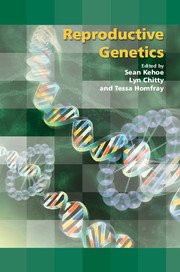Book contents
- Frontmatter
- Contents
- Participants
- Declarations of personal interest
- Preface
- 1 Genetic aetiology of infertility
- 2 Disorders of sex development
- 3 Preimplantation genetic diagnosis: current practice and future possibilities
- 4 Ethical aspects of saviour siblings: procreative reasons and the treatment of children
- 5 Epigenetics, assisted reproductive technologies and growth restriction
- 6 Fetal stem cell therapy
- 7 Prenatal gene therapy
- 8 Ethical aspects of stem cell therapy and gene therapy
- 9 Fetal dysmorphology: the role of the geneticist in the fetal medicine unit in targeting diagnostic tests
- 10 Fetal karyotyping: what should we be offering and how?
- 11 Non-invasive prenatal diagnosis: the future of prenatal genetic diagnosis?
- 12 Non-invasive prenatal diagnosis for fetal blood group status
- 13 Selective termination of pregnancy and preimplantation genetic diagnosis: some ethical issues in the interpretation of the legal criteria
- 14 Implementation and auditing of new genetics and tests: translating genetic tests into practice in the NHS
- 15 New advances in prenatal genetic testing: the parent perspective
- 16 Informed consent: what should we be doing?
- 17 Consensus views arising from the 57th Study Group: Reproductive Genetics
- Index
14 - Implementation and auditing of new genetics and tests: translating genetic tests into practice in the NHS
Published online by Cambridge University Press: 05 February 2014
- Frontmatter
- Contents
- Participants
- Declarations of personal interest
- Preface
- 1 Genetic aetiology of infertility
- 2 Disorders of sex development
- 3 Preimplantation genetic diagnosis: current practice and future possibilities
- 4 Ethical aspects of saviour siblings: procreative reasons and the treatment of children
- 5 Epigenetics, assisted reproductive technologies and growth restriction
- 6 Fetal stem cell therapy
- 7 Prenatal gene therapy
- 8 Ethical aspects of stem cell therapy and gene therapy
- 9 Fetal dysmorphology: the role of the geneticist in the fetal medicine unit in targeting diagnostic tests
- 10 Fetal karyotyping: what should we be offering and how?
- 11 Non-invasive prenatal diagnosis: the future of prenatal genetic diagnosis?
- 12 Non-invasive prenatal diagnosis for fetal blood group status
- 13 Selective termination of pregnancy and preimplantation genetic diagnosis: some ethical issues in the interpretation of the legal criteria
- 14 Implementation and auditing of new genetics and tests: translating genetic tests into practice in the NHS
- 15 New advances in prenatal genetic testing: the parent perspective
- 16 Informed consent: what should we be doing?
- 17 Consensus views arising from the 57th Study Group: Reproductive Genetics
- Index
Summary
Background
Genetic testing for single-gene disorders has been available in the NHS since the mid-1980s and for chromosomal disorders since the early 1970s. A mature network of multidisciplinary regional genetics centres has evolved combining clinical genetics and counselling, laboratory diagnostics and research. The link between research and diagnostics has proved to be an effective mechanism for rapid translation of tests and technologies into practice and the close involvement of clinical geneticists has meant that the introduction of new tests and gatekeeping of referrals to ensure appropriate use has been relatively effective. The professionally led network approach to test provision that avoided much duplication of service provision for single-gene disorders was formalised and supported by the Government through the formation of the UK Genetic Testing Network (UKGTN). A key part of the remit of the UKGTN is to evaluate new tests proposed for service and recommend them to specialist service commissioners for NHS funding. Our discussions will be limited to potentially heritable, germline genetic disorders.
The UK approach to genetic test evaluation
To fulfil its evaluation role, UKGTN adopted the ACCE framework (‘analytic validity; clinical validity; clinical utility; and ethical, legal, and social implications’) developed by the US Centers for Disease Control and Prevention and adapted by Kroese et al. into a practical system for individual laboratories to submit a data set for peer group evaluation. This ‘gene dossier’ consists of a number of headings designed to define the test precisely in a clinical context and set out its characteristics referenced against the research literature and the results of an adequate series of in-house validation tests.
Keywords
- Type
- Chapter
- Information
- Reproductive Genetics , pp. 193 - 198Publisher: Cambridge University PressPrint publication year: 2009



